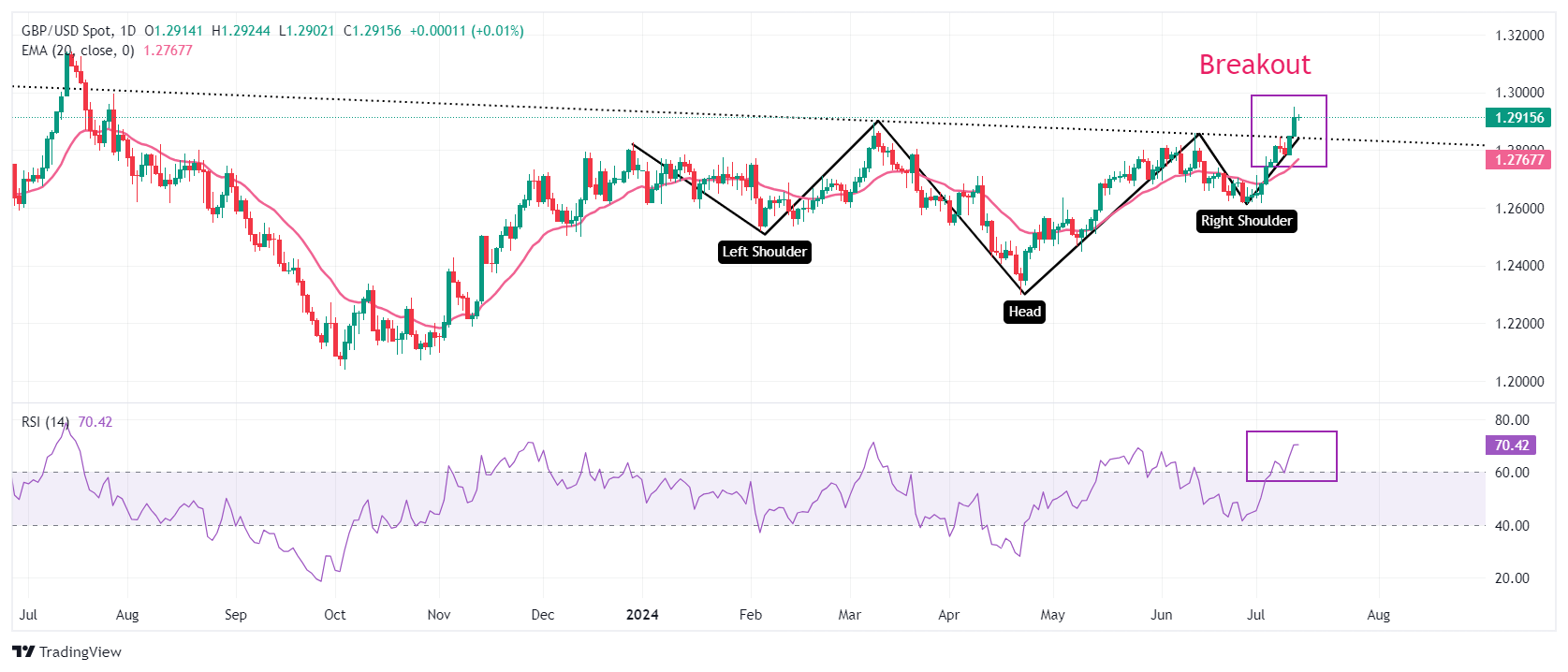Pound Sterling strengthens as Fed rate-cut in September seems certain

- The Pound Sterling holds strength against the US Dollar as Fed rate cuts become appropriate for this year.
- Softer-than-expected US inflation boosts hopes of Fed rate cuts in September.
- The UK economy grew at a faster pace of 0.4% in May, beating consensus of 0.2%.
The Pound Sterling (GBP) clings to gains slightly above the round level of 1.2900 against the US Dollar (USD) in Friday’s London session. The GBP/USD pair rose to a fresh annual high at 1.2950 after softer-than-expected United States (US) Consumer Price Index (CPI) data for June boosted expectations of rate cuts by the Federal Reserve (Fed). Traders bet that the Fed will start reducing interest rates from the September meeting.
The US CPI report showed that annual headline and core inflation, which strips off volatile food and energy prices, decelerated to 3% and 3.3%, respectively. On month, the headline inflation deflated for the first time in four years, prompted confidence that price pressures are on course to return to the desired rate of 2% and high inflationary pressures in the first quarter were a one-time blip.
Softer-than-expected inflation readings have weighed heavily on the US Dollar and boosted Fed officials’ confidence that the disinflation process has resumed. The US Dollar Index (DXY), which tracks the Greenback’s value against six major currencies, remains on the backfoot below 104.50.
On Thursday, San Francisco Fed Bank President Mary Daly said recent cooler inflation readings and easing labor market conditions have made one or two rate cuts appropriate for this year.
In Friday’s session, investors will focus on June’s US Producer Price Index (PPI) data, which will be published at 12:30 GMT. Economists expect that headline and core producer inflation accelerated in June on a monthly as well as annual basis.
Daily digest market movers: Pound Sterling capitalizes on UK political stability
- The Pound Sterling displays sheer strength against its major peers on Friday. The British currency strengthens as the outright victory of Keir Starmer’s Labour Party in parliamentary elections has resulted in the most stable political conditions in the United Kingdom (UK) economy among G-7 nations.
- The outlook for the Pound Sterling has improved, as a stable government results in predictable fiscal policies, which will attract significant foreign inflows. Also, the UK’s new Chancellor, Rachel Reeves, pledges to stimulate growth and investment with a major focus on the supply side due to the limited scope of government spending.
- Apart from that, the improved economic outlook and diminished expectations for the Bank of England (BoE) to begin reducing interest rates in August have boosted the Pound Sterling’s appeal. The monthly Gross Domestic Product (GDP) data for May came in higher at 0.4% from the estimates of 0.2% and an unchanged position in April. This has also raised doubts about whether the BoE should pivot to policy normalization in September.
- BoE policymakers hesitate to support early rate cuts as wage growth is roughly double than what is needed to be consistent for achieving price stability. On Wednesday, BoE policymaker Catherine Mann warned that the decline in the annual headline inflation to the 2% target was merely a “touch and go”. She warned that inflation could rise again and remain above the desired rate for the rest of the year.
Technical Analysis: Pound Sterling posts fresh annual high near 1.2950
The Pound Sterling posts a fresh annual high at 1.2950 against the US Dollar on Thursday. The GBP/USD pair strengthens after a breakout of an inverted Head and Shoulder (H&S) pattern formed on a daily timeframe. The neckline of the above-mentioned chart pattern is plotted near 1.2850, and a breakout of the H&S formation results in a bullish reversal.
Advancing 20-day Exponential Moving Average (EMA) near 1.2766 suggests that the near-term trend is bullish.
The 14-day Relative Strength Index (RSI) established into the bullish range of 60.00-80.00, indicating that the momentum has leaned to the upside.
Economic Indicator
Consumer Price Index ex Food & Energy (YoY)
Inflationary or deflationary tendencies are measured by periodically summing the prices of a basket of representative goods and services and presenting the data as the Consumer Price Index (CPI). CPI data is compiled on a monthly basis and released by the US Department of Labor Statistics. The YoY reading compares the prices of goods in the reference month to the same month a year earlier. The CPI Ex Food & Energy excludes the so-called more volatile food and energy components to give a more accurate measurement of price pressures. Generally speaking, a high reading is bullish for the US Dollar (USD), while a low reading is seen as bearish.
